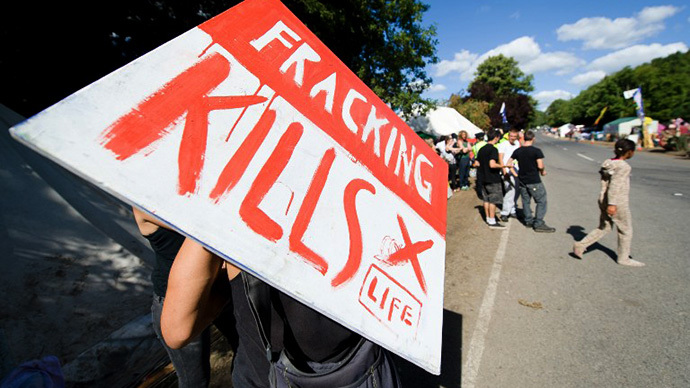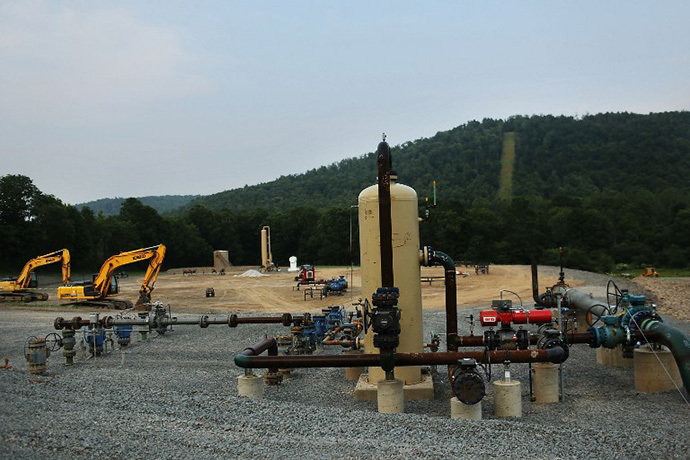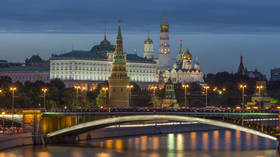Wrecking the Earth: Fracking has grave radiation risks few talk about

Environmentalists point to various dangerous consequences of using fracking technology, but none can be compared to the issue of radiation exposure and radioactive contamination of the development areas it poses.
UK government plans to use fracking technology in populated areas of the country recently drew hundreds of people to the streets in protests. Protesters pointed to the dangerous example of the US, the worldwide leader in fracking, where hydraulic fracturing (which consumes vast amounts of water) led to areas of Arkansas, Colorado, New Mexico, Oklahoma, Texas, Utah and Wyoming facing a dire water crisis.
Fracking involves toxic chemicals being lowered into kilometer-deep holes drilled in the ground to isolate gas and oil from shale. The toxic chemicals can then float into lakes and rivers or contaminate the ground. Also, fracking produces a disproportionate amount of waste, including radioactive water, which then has to be dumped somewhere.
The key to fracking
Uranium is the key element to fracking, or hydraulic fracturing,
to use its proper name. In the real-world version of Phineas
Fogg’s “Eighty Days Around the World,” burning the ship’s
masts and furniture to make steam, governments are now
encouraging the oil and gas merchants to blast their way deep
into the Earth to squeeze the last ounce of oil and gas from that
poor creature. But there will be a terrible revenge. Locked up in
the strata into which they pump the pressurized process water, to
fracture and thus create the huge surface area sponge which will
yield up its cargo of gas and oil, is a monstrous amount of
natural uranium and its deadly daughter Radium-226. And vast
amounts of the radioactive alpha emitting gas Radon-222, and its
own daughters Bismuth 214, Lead-210 and the alpha emitter
Polonium-210. Remember Polonium-210? That was the material used
when a few millionths of a gram poisoned ex-Russian agent
Alexander Litvinenko.
Deep down in the earth, there is a lot of radioactivity, which is
safe enough, so long as it is not brought up to the surface. The
technical term is NORM (Naturally Occurring Radioactive
Material). When it is brought to the surface it becomes
Technologically Enhanced, or TENORM, and it is a serious health
problem near oil wells and gas production sites. It is in the
production water, in the oil, in the gas, around the production
sites, the groundwater, in the pipes and tanks – and in your
kitchen.

The easy oil and gas deposits are those where there are
subterranean reservoirs, and the oil and gas can obtained by
drilling into the reservoir and then pumping down water to
displace the oil back up the drill pipe. These are now running
out, or are owned by people who control the flow and the price.
But there are many other deposits, where the resource is spread
throughout the rock, like water in a sponge. Fracking comprises
any method employed to break up the solid rock, shale or
sandstone to provide channels that allow the oil or gas in the
strata to more easily be pumped to the surface. Fracking is not a
new idea, but there are some new technologies being employed that
make it easy to obtain gas economically from such hitherto
unassailable rock sources. For reasons which I will outline, this
development has some worrying aspects.
The gas or oil will not normally be available because it is trapped in and interspersed through solid rock. To get it out you have to drill horizontally along the solid organic clay material, the shale, (or whatever oil-bearing rock type is there) and then break that unto small pieces in various ways so that the gas or oil can be pushed by the water you pump in back to the well pipe and up to the surface. The methods of breaking up the rock and holding the subsequent channels apart vary; put together they are “fracking”.
The shale strata are between 1,000 and 8,000 feet deep. Owing the weight of rock above, the pressure on the rocks in the gas bearing strata at these depths is enormous. The drill has to pass a tube (the “gun”) along the stratum for as long a length as possible and then this has to become perforated along its length with holes that allow the gas or oil to get into the tube and up to the surface.
Historically difficult. But technology has come to the rescue in the manifestation of specially designed explosives called “shaped charges.” These are cone-shaped dense metal explosive devices that send the explosive energy in an enormously powerful directed jet of metal atoms that act as a drill and melt the rock or shale along the length of the jet. This creates a radially distributed set of channels along and around the length of the drill tube, in the shape of a bottle-cleaning brush. Once this is done, water containing a whole range of acids and chemical additives is injected under immense pressure and this is followed up by small balls and sand or grit, termed “proppant” like the pit props in a mine, to hold the channels formed open. The extreme pressure pushes the weight of the upper layers of rock upwards and releases the tension in the strata where the gas is trapped. It has been noticed that the effect of all this on geophysical stability of the local deep earth results in small earth tremors and shocks, noticed by people living nearby. But the real cause of these tremors may be more sinister.
Nuclear implications
The metal which was formerly employed for the shaped charge head
or “gun” was copper. This creates a pressure of 300,000
atmospheres which pushes the rock aside by plastic deformation.
But in 1984 a US patent (US 4441428) was filed by one
Thomas Wilson, entitled “Conical Shaped Charge Liner of
Depleted Uranium.” The patent begins: “this invention
relates to a novel blasting device especially adapted for
drilling oil and gas wells.” Wilson records that DU is
5-times as efficient as copper in terms of the length of the
jetted hole, creating a pressure of 600,000 atmospheres. Because
of the uranium’s greater chemical reactivity it actually creates
new chemical compounds with the material in the rock (and the oil
and gas).

The DU cuts through the rock like butter, just as the military versions of this technology, which we believe has been fitted to missiles can cut through concrete reinforced bunkers. The multiple-shaped charge explosions will certainly shake the ground. The earth tremors and earthquakes are then not so hard to explain. Where do the process water acids, chemical compounds end up? At the surface? In the local aquifer? In the local rivers? Yes. But where to the DU nanoparticles from the shaped charge end up? Perhaps the mix of process water and chemicals spilled at the surface. Perhaps in the oil or in the gas. In your kitchen? No one looks, but someone should, since we know from the Iraq wars what these things can do to human health.
In case you might think this is all scaremongering, academic and unrelated to fracking, another patent was filed more recently in 2011 (US Patent 20110000669) by Halliburton (think: oil, gas, armaments, missiles, Dick Cheney) entitled “Perforating gun assembly and method for controlling wellbore pressure during perforating”. The patent specifically refers to Depleted Uranium.
So not only is there a lot of natural radioactive material surfacing in the gas or oil stream, and the production water, there is the possibility also a lot of unnatural radioactivity coming up from the DU shaped charges. And besides the fact that Depleted Uranium is the most efficient of these shaped charge metals, let’s not forget the attraction to the US nuclear industry of a way of getting rid of its vast stocks of Depleted Uranium, or even natural Uranium, or even nuclear waste. I mean, who is going to look at the radioactivity in the process water? It will be radioactive from the Radium and Radon daughters anyway. You would need to carry out some sophisticated analysis to see if it contained any nasty man-made radionuclides, especially DU nanoparticles. Who will do that?
Fracking contamination
The issue of natural radioactivity and fracking gas was raised by my friend, Marvin Resnikoff, who was an expert on the NORM cases. He has examined the fracking situation in relation to the exploitation of the Marcellus Shale gas, New York State. He pointed out that there were two critical issues. There is the concentration of Radium-226 in the rock. Then there is the length of time it takes for the gas to get to the kitchen.
Radon has a half-life of about four days, and so if the gas takes
a short time to get from the well production site to the
consumer, then levels in the kitchen can be significant. He
calculated that there would be between 1,000 and 30,000 extra
lung cancers in New York State from such an exposure. And that no
one in environmental protection agencies had paid any attention
to this issue.

This is certainly of concern, but there are other issues. The process water (and chemicals) certainly contaminates the areas around the gas production machinery. In a recent court case I was involved with in Louisiana there was a gas distribution plant that was scarily radioactive, and the land around it was also radioactive. I also studied oil well production areas in a Kentucky court case. The process water dissolves Radium-226 and this precipitates as scale on the pipes and tanks and is left on the ground near the wellheads and distribution facilities. The transfer pipes are radioactive. One of the worst radionuclides left behind is the Radon daughter Lead-210 which has a longish half-life (22 years) and builds up in these situations as a fine dust. It gets into the gas stream as nanoparticles and I believe it remains in the gas stream. It decays to Bismuth-210 which immediately decays to the alpha emitter Polonium-210 with a half-life of 138 days.
Fracking will increase the amount of Radon in the extracted gas. Why? Because of the high surface area created by smashing up the rock. In the simple gas or oil well there is a big cavern. The radon seeps out of the wall which has a surface area equal to that of the cavern wall. But in the case of the fracked strata, the surface area out of which the Radon can seep is enormously enhanced. So a faster Radon transfer can occur.
Burning our ship
So I conclude that fracking carries with it some serious health issues relating to radiation exposure and local contamination, issues which, as Marvin Resnikoff points out in his articles, have not been addressed properly (or at all) by the environmental impact statements published by the operators, or by the Environmental Protection Agency in the USA. The well heads and distribution areas will become radioactively contaminated. Isolated wells along the south coast of England, the Texas-ification of Sussex being encouraged by Prime Minister David Cameron, will not be like windmills. The contamination from the process water will get into the groundwater and drinking water. And let’s not forget the Depleted Uranium.

I don’t want to be all negative: oil and gas are valuable resources, and techniques for increasing availability have to be applauded, even if examined with more caution than they have been. But let’s finish by stepping back from all of this and asking what it’s for. The short answer, of course, is that it’s for money and cheaper energy, security, independence in energy terms from remote suppliers. But we know what it’s really for. It is the necessary fuel for the continuing economic system, the market-forces-driven, short-attention-span, continued global extravaganza of manufacturing, working, buying and selling that life has now become. Of course this can’t last since (fracking or not) the fossil fuel (and other fuels) will eventually run out, and/or the limited biosphere will die off from the toxic waste products of the activity, something that is currently happening at a frightening rate. But fracking will buy them more time.
As Phineas Fogg is completing his “Around the World in 80 Days” trip, he is forced to burn the cabin furniture, the masts and other critical pieces of the ship carrying him back on his final leg, to win his wager. But in the dismantling and burning of our planet, there is no wager, just greedy and powerful individuals. We are burning our ship – when it’s all we have.
The statements, views and opinions expressed in this column are solely those of the author and do not necessarily represent those of RT.
The statements, views and opinions expressed in this column are solely those of the author and do not necessarily represent those of RT.













